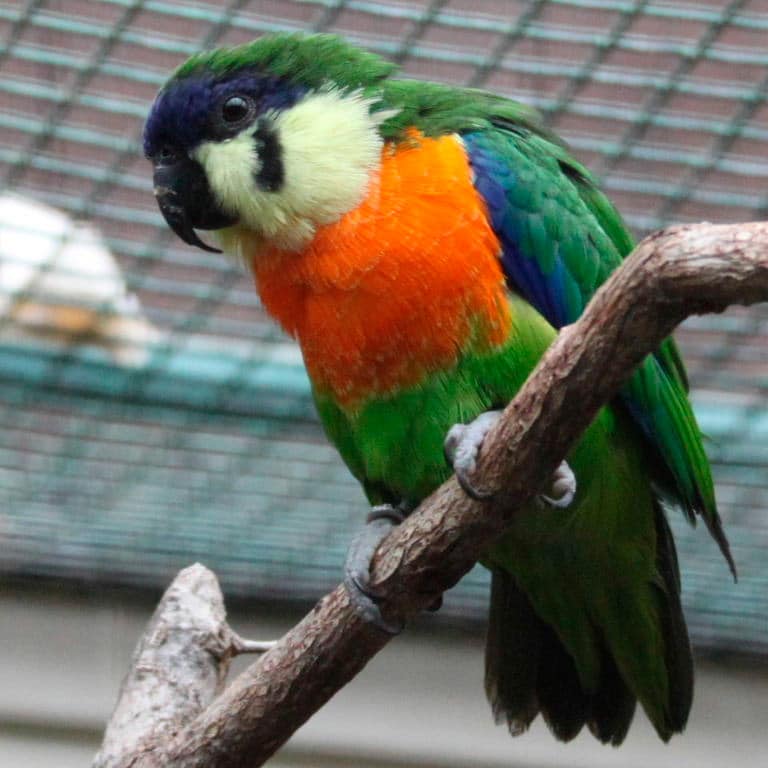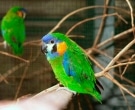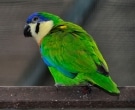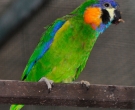Content
|
|---|
Description
11 to 13 cm.. length and a weight between 27 and 34 g..
The forecrown of the Orange-breasted Fig-Parrot (Cyclopsitta gulielmitertii), back of the crown and area behind the eyes are a deep blue; pale yellow the lores, throat and both sides of the head; black spot on the back of the cheek; Orange the top part of the abdomen; the interior of the wing-coverts Yellow-edged; wide bands of pale yellow under the wings. Bill blackish gray. The eyes dark brown.
The female similar to the male, but pale yellow on the front of the cheeks black and white on the back. Frontal of the cheeks bordered below green with blue stripe; the ear-coverts on both sides of neck, orange; underparts green.
The immature as females, but orange, Since the ear-coverts and sides neck to the area below, faced with the cheeks; chest male washed with orange-brown.
- Sound of the Orange-breasted Fig-Parrot.
Subspecies description
Habitat:
It is distributed in the rainforest, swamp forest, forest of Melaleuca , dense sheets and partially cleared areas from sea level to a 300 meters above sea level, rarely recorded in higher altitudes to the 800 m, the largest known altitude is 1.100 m.
They are usually in small groups assets of 6 to 10 individuals, whether it is flying above the treetops, or congregate where can feed on figs and other fruits in the canopy or plants at lower levels.
Bird feeding can be hard to spot, since they climb around the silent tree trunks, although they can pivot upside down as they feed, sometimes dropping food.
Reproduction:
The nests of the Orange-breasted Fig-Parrot found in arboreal termite, at the top of the trees of the forest. Up to three holes can be dug., and nesting they can be community. The nests also found at the base of a complex of epiphytes. There is little information available upon the breeding season, activity in apparent nests have been observed between the months of September and June. These sites can, However also, have been used to settle, and a record in January of a male regurgitating food near an entrance hole probably indicates breeding during that month at least..
Food:
The diet includes seeds of figs and other fruits, as well as small whole figs, nectar flower e insects occasional.
Distribution:
Widely distributed, abundant and easily observable in the lowland tropical rainforest, throughout much of New Guinea. The Orange-breasted Fig-Parrot most Western they are isolated, only seen in Salawati in the West of the islands of papua, and in the lowlands of theDoberai Peninsula, West Papua.
In other parts of New Guinea the range is continuous through the lowlands of the North of the eastern edge of Yellowfinch Bay around the memberamo river, throughout the region of the Sepik River and the lowlands of the Huon Peninsula, to Milne Bay, at the eastern end.
The range continues west through the southern lowlands of New Guinea through the Purari and Fly River regions to the southeastern lowlands of West Papua, on the 138 ° E; also in the islas Aru.
The Orange-breasted Fig-Parrot seems to be more common in southern New Guinea in the North.
Subspecies distribution
Conservation:
• Current IUCN Red List category: Least concern
• Population trend: Stable
The size of the world population It has not been quantified, due to the recent taxonomic divisions, Although it is estimated above 100,000 specimens.
The population suspected to be stable in the absence of evidence of any reduction or substantial threats.
"Orange-breasted Fig-Parrot" in captivity:
Rare in captivity.
Alternative names:
– Orange-breasted Fig-Parrot, Blue-fronted Fig-parrot, Orange-breasted Fig Parrot, Orange-breasted Fig-Parrot (nominate), Orange-breasted Fig-Parrot (Orange-breasted) (ingles).
– Psittacule à poitrine orange, Psittacule à poitrine orange (nominal), Psittacule à poitrine orange (nominale), Psittacule à poitrine orange (race nominale) (French).
– Orangebrust-Zwergpapgei (German).
– Cyclopsitta gulielmitertii (Portuguese).
– Lorito de Pecho Naranja, Lorito Pechinaranja (español).
scientific classification:
– Order: Psittaciformes
– Family: Psittaculidae
– Scientific name: Cyclopsitta gulielmitertii
– Citation: (Schlegel, 1866)
– Protonimo: Psittacula gulielmi III
Images “Orange-breasted Fig-Parrot”:
Videos "Orange-breasted Fig-Parrot"
————————————————————————————————
“Orange-breasted Fig-Parrot” (Cyclopsitta gulielmitertii)
Sources:
– Avibase
– Parrots of the World – Forshaw Joseph M
– Parrots A Guide to the Parrots of the World – Tony Juniper & Mike Parr
– Birdlife
– Loromania
– Photos:
(1) – animalphotos
(2) – A female Orange-breasted Fig-parrot in the Walsrode Bird Park, Germany By Quartl (Own work) [CC BY-SA 3.0], via Wikimedia Commons
(3) – A male Orange-breasted Fig-parrot in the Walsrode Bird Park, Germany – “Cyclopsitta gulielmitertii qtl1” by Quartl – Own work. Licensed under CC BY-SA 3.0 via Wikimedia Commons.
(4) – Birds-pet-wallpapers
(5) – animalphotos
– Sounds: Frank Lambert (Xeno-canto)






